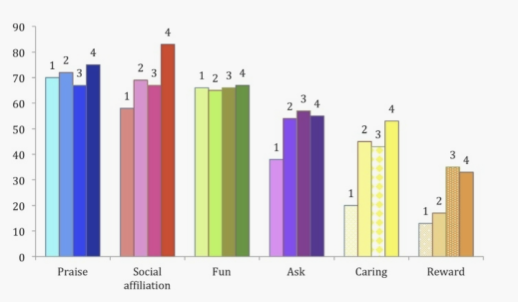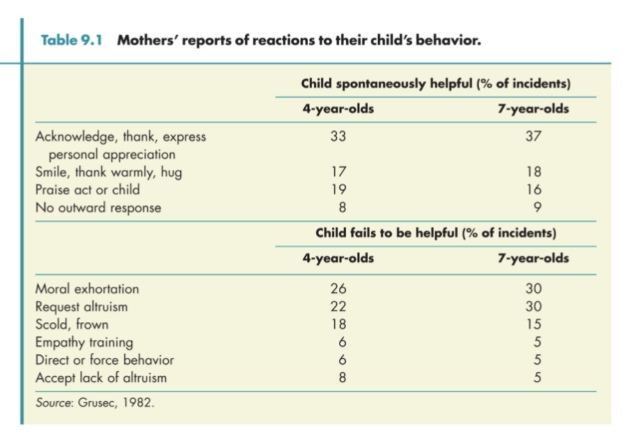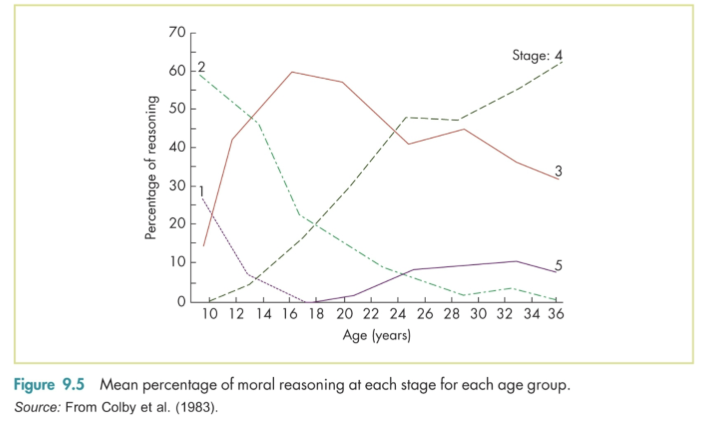Lecture 8: Development of Prosocial Behaviour and Moral Reasoning
1/31
There's no tags or description
Looks like no tags are added yet.
Name | Mastery | Learn | Test | Matching | Spaced |
|---|
No study sessions yet.
32 Terms
Prosocial Behaviour
“Voluntary behaviour intended to benefit another” (Eisenberg et al., 2006)
example; Sharing, helping, comforting
describe the difference between altruistic and prosocial behaviour
Altruistism - Motivated purely by desire to help another, at cost to oneself (ex.
Anonymous donation)
Prosocial - Pattern of behaviour that helps someone else , regardless of motivation (potential benefit/associated costs to the donor)
altruism can be prosocial but to all prosocial behaviour is altruistic
Why would people be prosocial?
Evolutionary roots: Increase survival of kin
– more likely to assist genetically related individuals (humans & nonhumans)
– it Benefits the survival of the group - safety in numbers e.t.c
Example: Eisenberg (1983) study found
– 7-17yr-olds more likely to help family, friends, similar background than strangers
beneficial on nuanced level
• Enhance reputation/acceptance within group, learn to follow norms of behaviour - enables you to operate well within that social group and not be outcasted
is humans being prosocial innate or learnt behaviour?
Are humans naturally prosocial? -
evidence to suggest innate -
– Spontaneous prosocial behaviour in children
from relatively early age
– Some evidence from twin studies of genetic
contribution to prosocial tendencies - more similar more like prosocial behaviour exhibition is
• Conditioned or socially learned?
evidence
– Early attachment to parents
– Parental/ adult responses to behaviour important - positive feponse to prosocial behaviour causes it to occur more in children - not innate.
Development of Prosocial Behaviour; when does prosocial behaviour emerge?
Around first birthday, helping behaviour
emerges
– Rapidly increases in toddler/preschooler
period, and then slowly thereafter into early
adulthood
– At least into late adolescence
– Shift to act according to moral principles, rather than for selfish motivations or to gain approval
how do we study the Development of Prosocial Behaviour
via experimental studies
Reinforce prosocial behaviour
– Prompting and reinforcement both encouraged prosocial donations (ex. Donation game)
– Explicit scaffolding (encouragement and praise) increases prosocial behaviour in infants (ex: Dahl et al., 2017)
• Modelling prosocial behaviour
– Observing helpful behaviour increases prosocial
behaviour in infants (ex: Schuhmacher et al.,
2018)
– Children who see model donate are more likely to
themselves (more impact than “preaching”)
– More likely to copy skilled, warm, and familiar
models
blue - when their modelling behaviour
orange - no modelling behaviour
helping overalll -
found that its the modelling behaviour which leads to most prosocial behaviour
its the modelling of the behaviour that It is most impactful - mores that communicating importance of prosocial behaviour to children

list the Potential Problems associated with prosocial behaviour
Artificial environment
– Unfamiliar experimenters, some deception
• Really measuring prosocial behaviour?
– No effect of modelling after 3-week follow-up
• Child just trying to puzzle out “right” solution or conform to adult demands?
– Zarbatany et al (1985): older children only affected by experimenter
influence, not peer influence
• measuring age differences in conformity
went into school and said class would be given money. - some told the whole class would know the amount the children requested - some groups where told only the expeirenmntor would know and that the whole class would know - tried to behave more prosaically towards adult than peers
some argue its just that children figure out what their expected to do in that specific environment - (Hawthorne effect!!)
observational studies to observe prosocial behaviour
attempt to overcome limitations asociated with artificial environment
conducted by parent/ experimenter
Observe spontaneous, naturally occurring behaviour (directly or through reports)
• Zahn-Waxler et al (2001): 14-36 months
– Mothers report responses to events in which negative emotions expressed
– Increase in empathic responses with age
• Harmond & Bromwell (2018)
– Parents asked to report on helping
behaviour and motivations children have to help mother in 1-4-year-olds
– Helping increased with age
these were the reasons/ motivations parents believed children have for helping - see graph
interesting reward is listed last - parents typically use reward based systems to incentivise children when trying to promote behaviours

Experimental study of spontaneous helping
Warneken & Tomasello (2006)
– 24 18-month-olds
– Experimental condition: looked at object and child, verbalized problem
(experiementro will drop something and then look at the object/ look at the child or make a neutral face towards the object and say “oh no”
– Control: neutral face toward object
• Examples:
– Hanging up clothes
– Opening cabinet
– Stacking books
– Retrieving spoon
children more likely to help in experimental condition - tend to help anyway even without eye contact
cases when they dont help - restricted by trying to figure out how to help/ solve problem not lack of desire to help
compared this to chimpanzees
Experimental study of spontaneous helping - findings
children more likely to help in experimental condition for most tasks
– Immediately in most cases – eye-contact and verbal announcement
unnecessary
– Restricted by ability to interpret goal/need
• Helped more than chimpanzees (ex:chimp)
– Unfamiliar adult
– More sophisticated cognitive skills
– Natural tendency to help others
increase down to human increase in cognitive skills - children showed more prosociality than chimps
take home message - we have a natural tendency to help others which is either innate or learnt in the very early stages of development
comparison to chimps unfair
chimps are helping different species - they suggest this is different to ask chimps to do
can’t conclude if we are more prosocial hat chimps based n this.
didn’t find that chimps helped - only every ¼ in conditions
what factors influence prosocial development
Parenting styles and response
– secure attachment = higher empathy
– Parents who are empathic, respond sensitively, encourage empathy
• Perspective-taking ability ; the ability to understand what others are feeling aid humans I behaving approapriatlyprscoailly as we are better bale to infer behaviours
• Ability to regulate emotions - e.g. children being upset when others are upset - contagion effect of these types of emotions ; being able to regulate own emotions enables us to better help others
• Cross-cultural differences ;
the types/ extent of prosocial behaviours encoruaged within different cultures e.g valuing competition over collaboration - individualistic societies - communicates what is modeled/ expected in social norms
– Values placed on cooperation vs. competition, individualism vs. support
study ;
observations ;
when their being helpful their less likely to not reposed at all
natural tenancy to want to encourage this type of behaviour
instances where child failed to eb helpful they tend to express

new topic
what is moral reasoning?
How we reason or judge whether an action is right or wrong
How does moral reasoning develop?
Piaget (of course!)
– Kohlberg
Piaget’s Theory of moral reasoning
watched hcildren play games e.g. game of tag Observed how children understood “rules of the game”, corresponds to “rules
of society”
– 3-stages of understanding
• Premoral (Up to 4 years): rules not understood
• Moral realism/Heteronomous (4 to 10): rules come from higher authority, cannot be changed - e.g. children not walking instead of running - 1 person suggests changing it and the other children say no because of this reason
• Moral subjectivism/Autonomous (10+): rules mutually agreed by players, can change - e.g. all agree to walk instead of run
• Linaza (1984): cross-cultural test
– English & Spanish children
– Confirmed Piaget’s findings
Piaget’s Theory of moral reasoning ; describe his description of the dilemma method
which child is naughtiest ?
Dilemma method: which child is naughtiest?
– Up to 9/10 years, children judge based on amount of damage, not
motive or intention
• Problems with this design? / interpretation
– Unequal damage distracts children;
– “bad intentions” are vague - not told in the story that the children were explicitly said forchilcfen not to conduct that behaviour
– Memory demands too high for young children; - too tricky for children to hold this info in their working memory
Criticism of Piaget’s Theory
Underestimation of ability?
– ex: if damage is equal, children as young as 5 yrs will judge based on
intent
– 2-5 yr olds can differentiate between violations of social convention and
moral conventions (Smetana, 1981)
breaking sa moral convention is worse than breaking a social convention in the eyes of children
Kohlberg’s Theory/ contribution
Expanded upon Piaget’s concepts;
– examined children Across the life-span, not just childhood
– conducted a Much more intense study of over 30 years
• Participants presented with stories of “dilemmas”
– Crucial aspect was why something was or wasn’t wrong
instead being asked what was wrong - looked at what wasn’t - he examined moral reasoning specifically
Kohlberg’s dilemma example
In Europe, a woman was near death from cancer. One drug might save her, a form of radium that a druggist in the same town had recently discovered. The druggist was
charging $2,000, ten times what the drug cost him tomake. The sick woman’s husband, Heinz, went to everyone he knew to borrow the money, but he could only get together about half of what it cost. He told the druggist
that his wife was dying and asked him to sell it cheaper or let him pay later. But the druggist said, “No.” The husband got desperate and broke into the man’s store to steal the
drug for his wife. Should the husband have done that?
Why?
why should the husband not do it?
Kohlberg’s Levels of Moral Reasoning
Developed 3 levels of reasoning absedonreponsses to prior question, each with 2 stages
– Preconventional
– Conventional
– Postconventional
Kholberg example
In Europe, a woman was near death from cancer. One
drug might save her, a form of radium that a druggist in
the same town had recently discovered. The druggist was
charging $2,000, ten times what the drug cost him to
make. The sick woman’s husband, Heinz, went to
everyone he knew to borrow the money, but he could only
get together about half of what it cost. He told the druggist
that his wife was dying and asked him to sell it cheaper or
let him pay later. But the druggist said, “No.” The husband
got desperate and broke into the man’s store to steal the
drug for his wife. Should the husband have done that?
Why?
Heinz’s Moral Dilemma
stage associated responses
He shouldn’t steal the drug because:
– Stage 1: “he might get caught”
– Stage 2: “it won’t do him any good because his wife will be dead when he
gets out of jail”
– Stage 3: “others will think he is a thief”
– Stage 4: “his wife’s condition doesn’t justify stealing”
– Stage 5: “although the druggist is being unfair, we must respect the rights
of others”
• Stage 6: He should steal the drug, but should give himself up. He’ll have to
pay the price, but will have saved a life.
Kholberg stages:
graph displaying how this developed in association with age

Preconventional Morality
based in Reason in relation to self, little understanding of shared rules
– Seek pleasure, avoid punishment
– typically prevalent in Children under 9, some adolescents, adult “criminal offenders”
• Stage 1:
– Concerned with authority, obey rules just to avoid punishment
more nuanced;
• Stage 2:
– Weigh the risks and benefits
– Recognize others might have different interests- still prioritise own needs;
– Action determined by one’s needs
Conventional Morality
mportance of rules, expectations, conventions of society
– Most adolescents and adults
• Stage 3: focus on interpersonal relationships
– Being good = having good motives
– Living up to what is “expected” of you
• Approval/disapproval of others important to you/ ho your closely affiliated with - incfluecned by this
(thinking about own social group)
• Stage 4: focus on society as a whole
– Performing one’s duty to maintain social order
(behaving in am oral way based on needs/ norms of wider society)
Postconventional morality
Understanding of moral principles underlying laws
• Stage 5:
– importance of functioning society AND individual rights
– Usually not until 20+ yrs, and not everyone!
• Stage 6
– Following universal ethical principles
– When law violates principle, act in accordance to
principle
prosocial behaviour ; Experimental and Observational studies
moral reasoning
Piaget
– Kohlberg
Real life examples! (Shapiro & Johnna, 1995) of kholbergs theory ;
"We shouldn't consider war..."
• "because it would hurt our economy..."(Stage 1)
• "because we'll have more money for domestic issues..."(Stage 2)
• "because we don' t want to appear too militaristic..."(Stage 3)
• "because war is killing and killing is against the law..."(Stage 4)
• "even though the situation is bad, war is damaging to people and property and
society agrees that is bad..."(Stage 5)
• "although atrocities have been committed, it would be an even greater atrocity to
wage war..." (Stage 6)
real quote taken from politicians
Criticisms of Kohlberg’s Theory
Dilemmas criticized for being too artificial, and not reliable
– Clinical interview method which is used too subjective - it does make it difficult to extrapolate info as tis not as standerdisedas we would want
** Better scoring system (Colby et al. 1987)
• Cultural Bias
example; (do addition readings on other studies)
– Snarey (1985) review of studies in 27 cultures
• Similar progression through stages 1-4, but Stage 5 only found in urban societies
• Biased toward cultures favouring individualism
** Approaches which take into account the diversity of values within
cultures
biased towards culture favouring individuals
Gender bias in his study;
– All original participants were male - can’t say something is universal moral reasoning if were only discussing one specific culture or gender
there is a gender bias
– Stages reflect specifically “male morality”
• Gilligan (1982)
– Criticized both Piaget and Kohlberg of negative views of “female morality”
– Argued females more concerned about impact behaviour has on others - there is a gendered cultured pressure on women mores than men in society
– “people before principles” (female) vs. “principles before people” (male) - difference between male vs female moralitywomen more likely to be cultured to behave this way - not saying its innate
gillian’s argument ;
Gilligan (1982, p.18)
“Prominent among those who thus appear to be deficient in moral development
when measured by Kohlberg’s scale are women, whose judgments seem to
exemplify the third stage of his six-stage sequence. At this stage morality is
conceived in interpersonal terms and goodness is equated with helping and
pleasing others. This conception of goodness is considered by Kohlberg and
Kramer (1969) to be functional in the lives of mature women insofar as their lives
take place in the home . . . . Yet herein lies a paradox, for the very traits that
traditionally have defined the “goodness” of women, their care for and sensitivity
to the needs of others, are those that mark them as deficient in moral
development.”
summary
Prosocial behaviour
– Develops rapidly throughout toddler/preschool years
– it is Shaped by reinforcement and modelling - really impactful
– Linked to many other cognitive abilities , perspective taking, memory e.t.c
– Are we inherently prosocial and this then encouraged or do we learn to be prosocial? -still remind to be answered (just thinking could be essay question)
• Moral reasoning
– Continues to develop into adulthood
– Views of morality shaped by culture
– More diverse, cross-cultural studies needed! (see Atari et al., 2020 for an example)
references not in book
Atari et al. (2020) Sex differences in moral judgements across 67 countries. . Proceedings of
the Royal Society B, 287, 20201201.
• Dahl et al (2017) Explicit scaffolding increases simple helping in younger
infants. Developmental Psychology, 53, 407–416.
• Eisenberg et al. (2006) Prosocial Development. In: Damon, Lerner, & Eisenberg (Eds.)
Handbook of Child Psychology.
• Hammond SI, Brownell CA. Happily Unhelpful: Infants' Everyday Helping and its Connections
to Early Prosocial Development. Front Psychol. 2018 Sep 21;9:1770. doi:
10.3389/fpsyg.2018.01770. PMID: 30298039; PMCID: PMC6160572.
• Schuhmaker et al (2018) Modeling prosocial behavior increases helping in 16-month-olds.
Child Development, 90(5), 1789-1801.
• Shapiro & Johnna (1995). Dr. Kohlberg goes to Washington: Using Congressional debates to
teach moral development. Teaching of Psychology, 22(4), 245-247